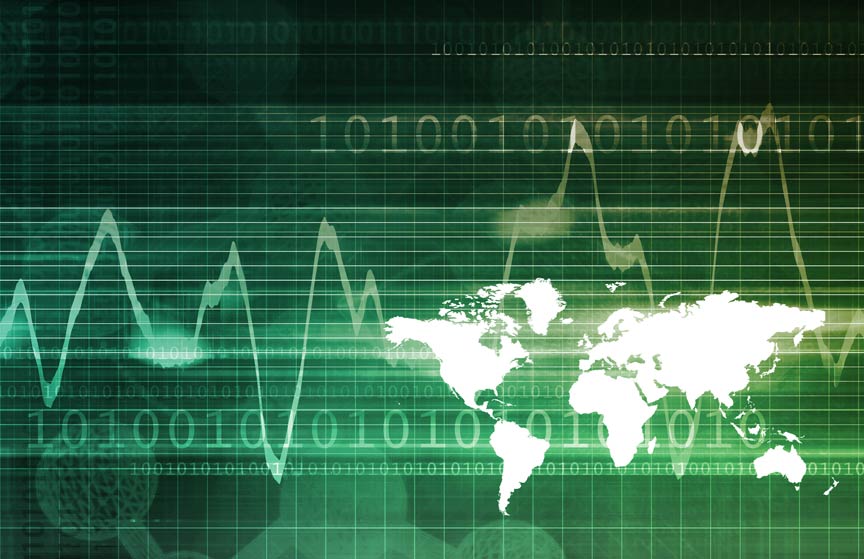
Common global Macro-economic indicators
Common Global Macro-Economic Indicators
Global macroeconomic indicators are statistics that represent the condition of a certain country or region’s economy. There are several types of global macroeconomic indicators, each one unique in their meaning, role, and impact. Generally, however, this data can be classified under one of two groups: leading indicators and lagging indicators.
Leading Indicators
As they reflect the initial phase of a new economic cycle, leading indicators such as interest rates, share prices, and yield curves are used to predict an economy’s direction. Here are five common types of leading indicators used today:
Stock market
The stock market is considered one of the most accurate indicators of economic health. However, prices are usually drawn from assumptions instead of a company’s actual value. This is why stock prices can be overestimated or underestimated.
Yet another issue is when investors and traders focus only on the stock market and fail to give attention to other macroeconomic indicators. This can make them too complacent and falsely optimistic, leading to market crashes.
Real Estate Market
A drop in housing prices hints that there are more houses than there are potential buyers, either because of exceedingly high prices or people simply don’t have the money to pay.
Also, the number of building permits may be used to assess economic health, as companies will normally seek these permits no later than six months prior to construction. When a new project begins, builders view it as a sign that the demand for houses is increasing. Otherwise, they adopt a less optimistic market outlook.
Bond Yields
When considering the bond market as a leading indicator, it is important to realize that the market is essentially hinged on economic expectations by investors and traders.
Hence, instead of relying on it when anticipating economic activity or movement, people should only use it as a barometer of market expectations. Of course, when looking at bonds, the best way is to analyze the yield curve.
A bond’s yield is how much money a trader might make in exchange for a bond. On a chart, the yield curve is a line showing bond yields having the same credit quality yet varying maturity dates. Theoretically, this means the graph is going up, where yields for longer-maturity bonds are higher.
Production and Manufacturing Statistics
Analyzing production and manufacturing statistics is probably one the fastest and simplest ways to obtain leading data on an economy’s health.
Higher production and manufacturing outputs are likely to increase gross domestic product (GDP) figures, where the development is seen as an indicator of higher consumption and positive economic movement. In any case, inventory levels and retail sales should be examined.
A bigger inventory can mean a higher consumer demand, but it can also show that products are not being sold.
Retail Sales
Generally speaking, higher retail sales are a sign of economic improvement. When consumers are confident in their economics, they will keep buying things even when unnecessary. Retail sales, however, are hardly an exact reflection of people’s spending.
For instance, there’s a possibility that they are borrowing money to continue spending. While this would lead to higher retail sales, the debt levels can point to a looming recession.
Lagging Indicators
Lagging indicators speak of an economy’s past performance and remain the same until a pattern is stabilized. Thus, they are used to ascertain that a trend is afoot. Below are the five most widely used lagging indicators at present:
GDP Growth
Gross domestic product (GDP) is the cash equivalent of all products and services a country produces. These statistics are typically used when comparing two economies and making growth predictions. When the GDP rises, it can bring the same effect on other indicators.
However, being a lagging indicator, GDP cannot offer much to traders and investors. There is, however, a theory that claims that when GDP rates drop for two successive quarters, it is a strong indication that recession is coming.
Inflation Rates
When the economy is growing, inflation is likely to increase, in turn raising interest rates as governments try to regulate prices. In an economic downturn, inflation is likely to drop or even enter a negative state (below 0%), a phenomenon called deflation.
While this seems like good news, it’s proof that consumer spending is going down. This usually comes with lower money supply and retail sales, as well as higher unemployment rates.
Currency Strength and Stability
When an economy is strong and steady, investors maintain a positive outlook and have no qualms spending more for the currency. Reciprocally, a strong currency makes a positive impact on the economy because of the resulting boost in purchasing power.
The effects of rising currency prices have a lot to do with a country being a net importer or exporter. If an economy is weak, it shuns investment and leads to a drop in currency value. This, in turn, causes a drop in the prices of exports. While this can be bad news for local companies, it can be a positive development for the global market as prices become more competitive.
Labour Market Statistics
There is probably no niftier lagging indicator than the unemployment rate, which, when increasing month-on-month for a certain duration, could indicate an ailing overall economy. If employment rates are going down, that means businesses are at the end of their rope and beginning to lay off employees.
Even if the economy seems to have bounced back, unemployment rates may still not improve as companies will always want to be absolutely certain before hiring people again.
Commodity Prices
When there’s an increase in the demand for commodities, like paint and cement, it is usually safe to assume that the economy is on the rise. Such supplies are usually required for infrastructure construction, which means the biggest commodity importers are up-and-rising market economies. Once the demand for such commodities goes down, it can be interpreted as a sign of a declining economy where building projects are becoming scarce.
Interest Rates – Leading or Lagging?
Finally, there are two conflicting sides when it comes to classifying interest rates as a global macroeconomic indicator.
Some argue that they belong to the leading group, while others claim they should be with the other. The truth is, interest rates are both lagging and leading. They are lagging because central banks decide to increase or decrease them after an economic or market activity.
At the same time, they are leading because as soon as such a decision has been made, the economy is likely to adjust with respect to the higher or lower rate.


